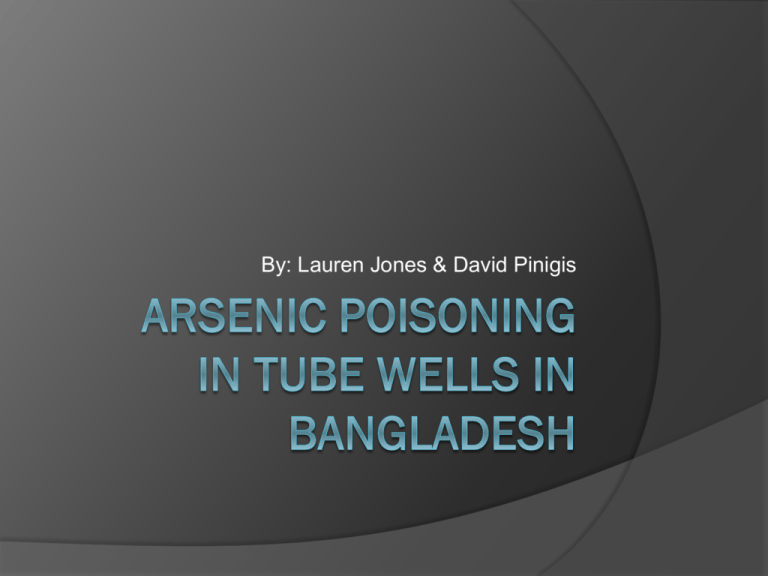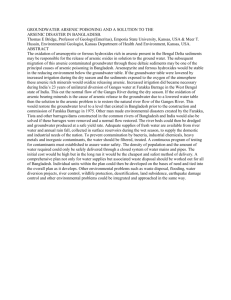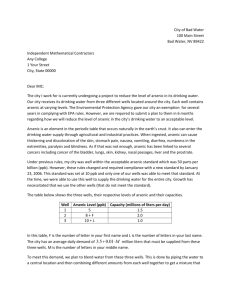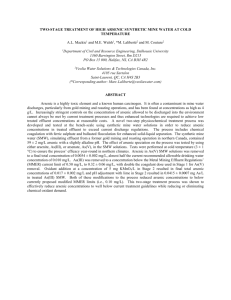Arsenic Poisoning in bangladesh & West Bengal
advertisement

By: Lauren Jones & David Pinigis Where can we find Arsenic? Arsenic can be found all over the world both from human activities and found in the earth crust. West Bengal and Bangladesh have a current problem with Arsenic in their water tube wells. The problem affects most villages surrounding the river Ganga in both West Bengal and Bangladesh. Arsenic can be found in 63 of the 64 districts in Bangladesh. How has Arsenic entered into the water sources? The problem started with malaria in the surface water. Around 2 million tube wells were dug to be used as the main source of water, they are as deep as 20-100 meters. The arsenic itself is geological and occurs in the alluvium along the river. Release of As is due to dropping water levels in the river, for agriculture uses, allows for oxidation of the As. Another source is from the water running over As rich rocks into the wells. Background on Arsenic(As) According to the U.S. Agency for Toxic Substances and Disease Registry, arsenic is the number one most hazardous substances. Is a metalloid, and stable in most oxidation states. Taste less, color less, and odor less. The lethal dose for humans is 125 mg. It ranks 20th in abundance in the earth’s crust compared to other elements. As is mostly excreted through urine, skin hair, but in excess in can be deposited into tissues, which can lead to inhibition of cellular activities. Effects of Arsenic Poisoning Melanosis (darkening of the skin) Keratosis (growth of keratin on the skin) Dark spots on the chest, back, limbs, and gums Enlargement of the liver, kidneys, and spleen Short Term Cancers of the skin, lung, or bladder Reproductive disorders Blood vessel diseases in the legs and feet. Nephropathy (damage or disease of the kidney) and hepatopathy (disease or disorder of the liver) Gangrene (death of tissues in part of the body) Long Term EPA and WHO Standards EPA standard for arsenic in drinking water is 10 ppb, which replaced the old standard of 50 ppb in 2001. WHO has the standards of 0.01mg/L in drinking water for Europe and North America. The WHO standard for Bangladesh still stands at 0.05mg/L A 1998 British Geological Survey, revealed that 46 percent of tube wells contained arsenic above 0.010 mg/L and 27 percent above 0.050 mg/L What Is Currently Being Done To Address The Problem? Pumps are being painted red to show that the well which they tap into is contaminated with arsenic. Studies are being done in different villages around Bangladesh each using various removal methods, but there has not been any specific implementation of those methods throughout Bangladesh or West Bengal. Non-Phytoremediation Methods for Removal A household filtration system consisting of a bucket sand filter and a coagulant consisting of phosphate and silicate. The household treatment has shown a decrease from 300µg/L down to 50µg/L Arsenic Removal Using Bottom Ash (ARUBA) a process of taking well water and adding coal ash to the water. The result is the removal of arsenic from 200 – 900 ppb down below the standard for Bangladesh of 50 ppb. The SONO filter is a stack of two buckets containing fine and coarse river sand, an iron matrix, wood charcoal, and wet brick chips, the water then runs through the two buckets removing arsenic. Latin America Used Filtration System Types of filtration: Coagulation/filtration, iron/manganese oxidation, lime softening, Coagulation/filtration process: Remove suspended colloids by changing physical and chemical properties which result in particles settling down and being filtered out. Removal of Arsenite less effective then Arsenate depending on the pH. Reported 375.7µg/L before filtration – after 120 minutes As concentration was between 10µg/L and 50µg/L Pteris Vittata as a Hyperaccumulator A hyperaccumulator of arsenic must have a minimum concentration of 1000 mg/ kg in the aboveground biomass. Chinese Brake was first found on a site that was contaminated from pressuretreating lumber using chromated-copperarsenate. Arsenic concentrations were found in the fronds ranged from 1114 to 2046 mg/ kg after growing in contaminated soil containing 245 mg/ kg arsenic for 8 weeks. Pteris Vittata •One plant grown in 600 mL of groundwater reduced the arsenic concentration from 46 to less than 10 μg/L in 3 days. •Reused plants continued to take up arsenic, but at a slower rate. •Younger fern plants were also more effective than older plants at removal. •The addition of phosphate nutrition reduced its arsenic affinity and inhibited removal. Distribution of As In Different Pteris Species In Frond and Root Tissue •Plants generally contained a greater percentage of As (III) (79–94%) than As (V) in the fronds. •As (III) is a compound with extremely high toxicity. • As (III) induces enzyme inactivation 100 90 80 70 60 50 40 30 20 10 0 P. biaurita P. quadriaurita P. cretica P. ryukyuensis %As(V) %As(III) Fronds %As(V) %As(III) Roots Where In pteris vittata Is As Being Stored? By the use of Extended X-Ray Absorption Fine structure (EXAFS), on samples taken from the lamina of the frond, stipe and root. Most of the arsenic found in all of the tissues was found in the form or arsenite. The greatest accumulation was found in the epidermal and mesophyll cells of the lamina near the blades of the fern. Another study also found that the majority of arsenic was found in the frond and roots of the plant tissues. The distribution pattern of the As was found to be in sequence with its hyperaccumulating ability. Beneficial Phytoremediation Rhizosphere microorganisms. Pseudomonas can use As since some properties are close to phosphates they are solubilized and taken up in phosphate transporters. Also have an enzyme arsenate reductase and also have arsenic oxidase. Transform As to a form more available to plants which positively increased the viability, growth and development on plants when on polluted soils of As. Positive: use microbes and genetically altered plants to make As more bioavailable Positive: more appealing then chemical treatment Risk: genes could escape but the seeds do not survive with large amounts of As Risk: takes time Our Proposal We would use the pteris vittata because versatile and hardy, have a large biomass, fast growing, easy to reproduce and are perennial plants We would use hydroponic system which the water would be pumped through the pteris vittata to clean the water of the As. The storage tank would then collect the cleaned water, the tank would be used to prevent the chance of malaria outbreaks. Question or Comments? Bibliography Abernathy, Charles O., Rebecca L. Calderon, and Willard R. Chappell. Arsenic: Exposure and Health Effects. London: Chapman & Hall, 1997. Print. Ahuja, Satinder. Arsenic Contamination of Groundwater: Mechanism, Analysis, and Remediation. Hoboken, NJ: Wiley, 2008. Print. "Arsenic Contamination of Groundwater in Bangladesh." Http://www-tc.iaea.org/tcweb/publications/factsheets/arsenic_contamination.pdf. Internation Atomic Energy Agency. Web. 7 Nov. 2010. "Arsenic in Drinking Water | Arsenic | US EPA." EPA Office of Water Home | Water | US EPA. Web. 9 Nov. 2010. <http://water.epa.gov/lawsregs/rulesregs/sdwa/arsenic/index.cfm>. Bundschuh, Jochen. Natural Arsenic in Groundwaters of Latin America. Boca Raton [Fla.: CRC, 2009. Print. Category, By. "Available Technologies." Lawrence Berkeley National Laboratory. Web. 15 Nov. 2010. <http://www.lbl.gov/techtransfer/techs/lbnl1742.html>. Charlson, Joe. "Phytoremediation of Arsenic Joe Charlson ABSTRACT Arsenic Is Listed as the Number One Hazardous Substance by The U.S Agency for." Google. Web. 9 Nov. 2010. <http://74.125.155.132/scholar?q=cache:2m5f_c-4uVsJ:scholar.google.com/ phytoremediation of arsenic&hl=en&as_sdt=4000&as_vis=1>. "CHERIC DB." CHERIC. Web. 9 Nov. 2010. <http://www.cheric.org/research/tech/periodicals/vol_view.php?seq=442083&start=0&number=3&jourid=13&vol=10&num=3&totalcount=25>. Conlan, Meath. "Bangladesh: Filtering Arsenic from Drinking Water « Diverse Journeys." Diverse Journeys. 2 Aug. 2010. Web. 9 Nov. 2010. <http://diversejourneys.com/?p=1290>. "EnviroNews Archives - Chinese Brake Fern - A Potential Phytoremediator of Arsenic Contaminated Soil and Water." International Society of Environmental Botanists (ISEB). Web. 18 Nov. 2010. <http://isebindia.com/01_04/03-07-2.html>. "Fiberglass Storage Tanks for Chemicals, Water, and Oils." Fiberglass Tanks, Enclosures, Buildings, Shelters, Syrupkettles, Sugar Kettles, Pools. Web. 18 Nov. 2010. <http://www.p123.com/tanks.html>. Ghosh, Rash. "Arsenic Contamination in the Bengal Basin." Internation Institute of Bengal Basin. Web. 9 Nov. 2010. MA, Lena, Royale Underhill, Randolph Duran, and Mark Davidson. "Spatial Distribution of Arsenic Species in Brake Fern (Pteris Vittata L.) Using X-ray Absorption Spectroscopy." The American Society of Plant Biologists: Abstract Center. Web. 09 Nov. 2010. <http://abstracts.aspb.org/pb2002/public/P64/0338.html>. Meng, Xiaoguang, and Greg Korfiati. "Removal of Arsenic from Bangladesh Well." Unu.edu/env/Arsenic/Meng.pdf. Center for Environmental Engineering. Web. 15 Nov. 2010. Miller, Clint. "Arsenic Poisoning « Environmentalchristian’s Weblog." Environmentalchristian’s Weblog. 2007. Web. 18 Nov. 2010. <http://environmentalchristian.wordpress.com/2008/02/29/arsenic-poisoning/>. "Scientific Facts on Arsenic." GreenFacts - Facts on Health and the Environment. Web. 7 Nov. 2010. <http://www.greenfacts.org/en/arsenic/index.htm>. Srivastava, Mrittunjai, Lena Ma, and Jorge Santos. "Three New Arsenic Hyperaccumulating Ferns." Science Direct. 20 Dec. 2005. Web. 09 Nov. 2010. <http://lqma.ifas.ufl.edu/Publication/Mrs-06.pdf>. Tu, S., Lena Ma, Abioye Fayiga, and Edward Zillioux. "Phytoremediation of Arsenic-Contaminated." Internation Journal of Phytoremediation. 2004. Web. 15 Nov. 2010. <lqma.ifas.ufl.edu/Publication/Tu-04d.pdf>. "WHO | Arsenic in Drinking Water." World Health Organization. Web. 9 Nov. 2010. <http://www.who.int/water_sanitation_health/dwq/arsenic/en/>. "WHO | Towards an Assessment of the Socioeconomic Impact of Arsenic Poisoning in Bangladesh." World Health Organization. Web. 15 Nov. 2010. <http://www.who.int/water_sanitation_health/dwq/arsenic2/en/index3.html>. "WHO | Water-related Diseases." World Health Organization. 21 May 2001. Web. 18 Nov. 2010. <http://www.who.int/water_sanitation_health/diseases/arsenicosis/en/>. "Worst Mass Poisoning in History ? « Colonel Speaks." Colonel Speaks. 22 June 2010. Web. 18 Nov. 2010. <http://colonelspeaks.wordpress.com/2010/06/22/worst-mass-poisoning-in-history/>.









